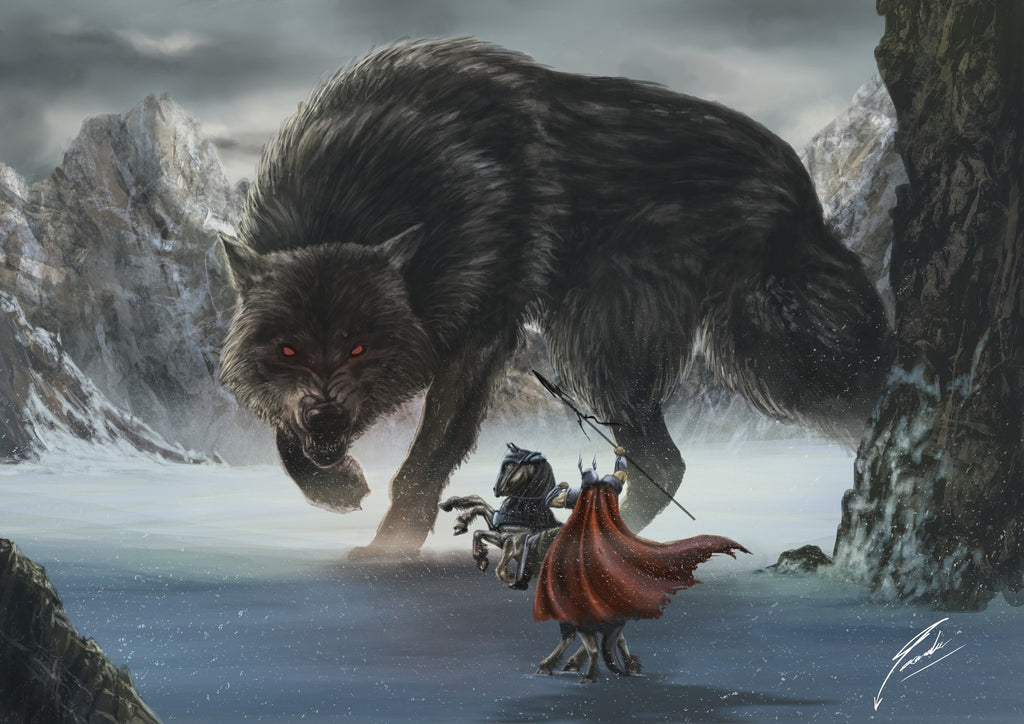Wolves in Norse Mythology: Powerful and Cruel?
Fenrir was a famous name in Norse mythology. What many might not know is that, there were two more wolves in Norse myth who were nearly that powerful. In this blog post, we discuss their origin and their power in the myth.
Fenrir the Wolf
Fenrir was the son of Loki and the giantess Angrboda who brought only grief and sorrow to those she wanted to suffer. He had some other powerful siblings as well: Jormungandr and Hel - both of whom had special roles in Norse myth.
Fenrir was born by Angrboda but he was raised by Norse gods. As Odin learnt of what Fenrir would be capable to do in the future, he decided to bring Fenrir to Asgard. But what the gods didn't think of was Fenrir grew up at an incredible speed.

He grew up to the size that gods could no longer keep him running around Asgard. They decided to bind them to a rock with a magical chain with a hope of keeping him there forever. But of course, Fenrir broke himself free. One part of his power was revealed here.
The magical chain was undoubtedly the best chain in the cosmos because it was made by the dwarves (in case you miss it, dwarves made Mjolnir hammer and Gungnir spear of Odin). But Fenrir could break it to join Ragnarok with his father.
What he did in Ragnarok was more than terrible. Maybe the jotun side of Fenrir was finally revealed here too. He would kill anything that dared to appear in his path. He stretched his jaws from sky to earth swallowing whatever in his sight. No excuse, no mercy.
And the final point was when he swallowed Odin. That's what the prophecy said for the fate of Odin the Allfather. Wolf swallowed the High One followed by the collapse of Norse Pantheon. We didn't know exactly how Fenrir did it. But things happened Norse myth.
Hati and Skoll
From what we have from surviving sources, Norse mythology had it that Fenrir had two sons - Skoll and Hati (treachery and mock)
The identity of the wolves' mother remained a mystery. Some said it was Angrboda who gave birth to Hati and Skoll (yes, with Fenrir - her own son). Some claimed that it was a giantess who had the appearance of a wolf. But whatever sources we have, we are sure who could be the mother of these powerful wolves.
In Norse mythology, Hati and Skoll spent everyday chasing after the sun and the moon. But it was not until Ragnarok that they managed to chase down the two beautiful stars.

Then they devoured the Sun and the Moon sending the whole cosmos into blackness. Norse cosmos lost both shining stars, nothing could be seen, and Surtr the fire giant even set the whole cosmos on fire.
Garm
Grímnismál, one of the famous poems from Poetic Edda, Garm was believed to be the superior canine just like Odin the Allfather to the gods or Yggdrasil to the trees:
The best of trees
Must Yggdrasil be,
Skíðblaðnir best of boats;
Of all the gods
Is Óðinn the greatest,
And Sleipnir the best of steeds;
Bifröst of bridges,
Bragi of skalds,
Hábrók of hawks,
And Garm of hounds
In Völuspá, another famous Eddic poem, Garm was also mentioned, but not as a hound, a wolf instead.
Now Garm howls wildly
Before Gnipa Cave.
Chains will snap
And the wolf shall run.
In the Grímnismál, Garm was called as the hound while the Voluspa called him "freki" meaning "wolf". The sight of a wolf breaking himself free from the chains surely reminds us of the day Fenrir broke himself free to trigger off Ragnarok Doom of the Gods. Fenrir was tied up by the gods to prevent him from devouring the cosmos. But what was written in the fate would come. The two images of two wolves under the fetter finally smashed the chain definitely make us link Fenrir and Garm as one figure.
Freki and Geri
In Norse mythology, Odin had for himself a pair of wolves whose names were Geri and Freki. They were often described to lie next to the throne of Odin the Allfather. Odin shared all of his food to the wolves and he only kept wine for himself.
AnotThere




